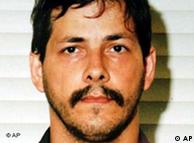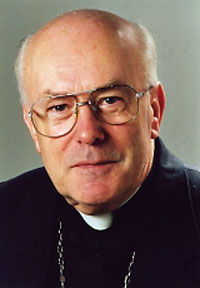
Marc Dutroux

Cardinal Godfried Daneels
When they searched retired Cardinal Danneels’ residence, Belgian police discovered confidential court records on the Dutroux murder-pedophile case. Church officials claim to be completely unaware of the existence of such files.The files contain hundreds of pictures of the corpses of the murdered girls and of the cells in which they were kept. It is hard to imagine why Cardinal Danneels had such files all, and in particular why he kept them in his home.
The Marc Dutroux case was one of the most explosive criminal cases in post-war Europe. It reads like the script from a horror movie.
Allegations, never totally answered, circulated that the pedophilia ring extended very high indeed in Belgian society, and that the Belgian government stymied the investigation to protect higher-ups.
Wikepedia summarizes the case:
Born in Ixelles, Belgium on November 6, 1956, Dutroux was the oldest of five children. His parents, both teachers, emigrated to the Belgian Congo, but returned to Belgium when Dutroux was four. They separated in 1971 and Dutroux stayed with his mother. He worked briefly as a gigolo, serving men. He married at the age of 19 and fathered two children; the marriage ended in divorce in 1983. By then he already had an affair with Michelle Martin. They would eventually have three children together, and married in 1989 while both were in prison. They divorced in 2003, also while in prison.
An unemployed electrician, Dutroux had a long criminal history involving car theft, muggings and drug dealing.
In February 1986, Dutroux and Martin were arrested for abducting and raping five young girls. In April 1989, he was sentenced to thirteen and a half years in prison. Martin received a sentence of five years. Showing good behaviour in prison, Dutroux was released on parole in April 1992, having served only three years. On releasing him, the parole board received a letter written by Dutroux’s own mother to the prison director, and she stressed concern that he was keeping young girls in his house.
Following his release, Dutroux was able to convince a psychiatrist that he was disabled, resulting in a government pension. He also received sleeping pills and sedatives, which he would later use on the abducted girls.
Dutroux’s criminal career, involving the trade of stolen cars to Czechoslovakia and Hungary, drug dealing and also violent crimes such as mugging, gained him enough money to live in relative comfort in Charleroi, a city that had at the time high unemployment. He owned seven small houses, most of them vacant, and used three of them for the torture of the girls he kidnapped. He lived mainly in his house in Marcinelle near Charleroi (Hainaut), where he constructed a concealed dungeon in the basement. Hidden behind a massive concrete door disguised as a shelf, the cell was 2.15 metres (7 ft) long, less than 1 metre (3 ft) wide and 1.64 metres (5 ft) high.
Julie Lejeune and Mélissa Russo (both aged eight) were kidnapped together from Grâce-Hollogne on June 24, 1995, probably by Dutroux, and imprisoned in Dutroux’s cellar. Dutroux repeatedly sexually abused the girls and produced pornographic videos.
On August 22, 1995 Dutroux kidnapped 17-year-old An Marchal and 19-year-old Eefje Lambrecks who were on a camping trip in Ostend. He was probably assisted by his accomplice Michel Lelièvre, who was paid with drugs. Since the dungeon already contained Lejeune and Russo, Dutroux chained the girls to a bed in a room of his house. His wife was aware of all these activities. Dutroux killed the two girls several weeks later by drugging them and burying them alive at one of his properties in Jumet.
In late 1995, Dutroux was arrested by police for involvement in a stolen luxury car racket. He was held in custody for three months between December 6, 1995 and March 20, 1996. During this period, Lejeune and Russo starved to death in the dungeon.
Two months after his release, Dutroux, with help from Lelièvre, kidnapped 12-year-old Sabine Dardenne who was on her way to school on May 28, 1996. She was imprisoned in the dungeon. On August 9, 1996, the two men kidnapped 14-year-old Laetitia Delhez when she was walking home at night from a public swimming pool. But an eyewitness identified part of a license plate which matched a vehicle registered to Dutroux. He, his wife and Lelièvre were all arrested on August 13, 1996. An initial search of his houses proved inconclusive. But two days later, Dutroux and Lelièvre both made confessions. Dutroux led the police to the basement dungeon where Dardenne and Delhez were found alive on August 15, 1996. In an interview conducted several years later, Dardenne revealed that Dutroux had told her that she had been kidnapped by a gang but her parents did not want to pay the ransom and the gang was planning to kill her. Dutroux said he saved her, and that he wasn’t one of gang she should fear. He let her write letters to her family, which he read but never posted.
On August 17, 1996 Dutroux led police to another of his houses in Sars-la-Buissière (Hainaut). The bodies of Julie Lejeune and Mélissa Russo as well as another accomplice Bernard Weinstein were found in the garden. An autopsy found that the two girls had died from starvation. Dutroux said he had crushed Weinstein’s testicles until he gave him money, he then drugged him and buried him alive. Later Dutroux told the police where to find the bodies of An Marchal and Eefje Lambrecks. They were located on September 3, 1996 in Jumet (Hainaut), buried under a shack next to a house owned by Dutroux. Weinstein had lived in that house for three years.
During the several police, several hundred commercial adult pornographic along with a large amount of home-made sex films that Dutroux had made with his wife Michelle Martin were recovered from his properties.
This spectacular failure of the Belgian criminal justice system may not have been caused by sheer incompetence: at least that was the opinion of the original judge in the case:
Authorities were criticised for various aspects of the case. Perhaps most notably, police searched Dutroux’s house on December 13, 1995 and again six days later in relation to his car theft charge. During this time, Julie Lejeune and Mélissa Russo were still alive in the basement dungeon, but they were not found. Since the search was unrelated to kidnapping charges, police searching the house had no dogs or specialised equipment that may have discovered the girls’ presence, and they failed to notice the significance of the freshly plastered and painted wall that concealed the dungeon, in an otherwise decrepit and dirty basement. While in the basement, officers heard children’s cries, which they decided had come from the street outside. The lead officer in the search was Rene Michaux (now deceased) who is widely believed in Belgium to have been part of a cover up by the authorities.
Several incidents suggested that Dutroux’s intentions were not properly followed-up. Dutroux had offered money to a police informer for providing girls, and told him that he was constructing a cell in his basement. His mother also wrote a second letter to police, claiming that he held girls captive in his houses.
There was widespread anger and frustration among Belgians due to police errors and the general slowness of the investigation. This anger culminated when the popular investigative judge in charge of the case was dismissed after having participated in a fund-raising dinner by the girls’ parents. His dismissal resulted in a massive protest march (the “White March“) of 300,000 people on the capital, Brussels, in October 1996, two months after Dutroux’s arrest, in which demands were made for reforms of Belgium’s police and justice system.
On the witness stand, Jean-Marc Connerotte, the original judge of the case, broke down in tears when he described “the bullet-proof vehicles and armed guards needed to protect him against the shadowy figures determined to stop the full truth coming out. Never before in Belgium has an investigating judge at the service of the king been subjected to such pressure. We were told by police that [murder] contracts had been taken out against the magistrates.” Connerotte testified that the investigation was seriously hampered by protection of suspects by people in the government. “Rarely has so much energy been spent opposing an inquiry,” he said. He believed that the Mafia had taken control of the case.
A 17-month investigation by a parliamentary commission into the Dutroux affair produced a report in February 1998, which concluded that while Dutroux did not have accomplices in high positions of police and justice system, as he continued to claim, he profited from corruption, sloppiness and incompetence.
“Within four years of being released early from jail, where he had served time for rape and kidnapping, Mr. Dutroux — whose only official income was a welfare check — was worth an estimated 6 million francs, suggesting to investigators that he was acting for others higher up in a pedophile and prostitution ring.”
I have the records of the Erickson murder case in Wisconsin. A young priest murdered two people to cover up his sexual abuse. The church does not come off well. It comes off even worse in the Irene Garza murder case. His supervisors protected a priest, John Feit, who, the police say, had murdered a young woman.
Why did Danneels have those records on the Dutroux case, and why did he hide them?

The White March Protesting the Handling of the Dutroux Case
Update: Investigators questioned Danneels for ten hours today.
Update: The spokesman for the Belgian bishops claims that the Detroux dossiers were not paper dossiers but cd roms, which were sent to journalists and others, and that they had been given to Danneels by a person well known to the press.
But why? – if the Church had no connection with the Detroux case.